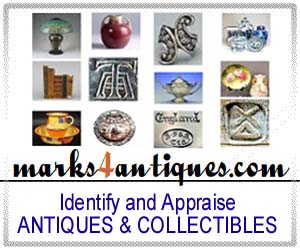DIFFERENCES BETWEEN ANTIQUE CHINESE PORCELAIN AND RECENT REPRODUCTIONS

Our research team at marks4antiques.com has been monitoring trends in fake items while updating our online reference guides and found some striking results. After sorting through hundreds of mystery porcelain and chinaware marks discovered on various items that have been questioned by our members, it appears that there is a notable rise in the number of new Kanji symbols, which, unlike the recent past when forgeries were mainly on European-styled decoractive items, most of these new ones are on recently imported reproductions in the Chinese style.
“Almost 2 out of every 3 questions we receive from our members are for fake marks on Chinese styled porcelain” said Elizabeth, in charge of the Ceramics research group for the company. “We are stunned. This represents a three-fold increase on questions to identify Chinese marks from just a couple of years ago” she continued.
For the most part of the 2nd half of 20thC, markings found on European-styled porcelain reproductions from Asia were realistic combinations of much older German, British or French porcelain marks. These faked marks were copies or forgeries of much older registered trademarks, but whose copyright had expired or the companies that used them are now closed. The lack of any real signs of age on an item and other factors were usually sufficient to confirm that any notable variations on the marks were indeed indicative of forgery and not yet another old mystery mark to be researched. The intention of these marks is clear: since old European & American porcelain makers retain a strong reputation for quality and superb designs, inexpensive Chinese or Asian imports offered an alternative abundant supply to satisfy the increased appetite for traditionally-styled decorative items and chinaware by collectors, which essentially saturated the market with reproductions in the old European taste. As a consequence, not only many established and still surviving American and European factories found it difficult to compete, but if anything, several joined the fray and lately have their own designs made overseas for a fraction of the cost, while still signing their wares with their logo of high repute. Many of these are sold through expensive or luxury retailers.

However, the emphasis nowadays is on reproductions of Chinese antiques. There seems to be a new and much more virulent resurgence of Chinese Export Porcelain, to the point that we hear substantiated accounts of whole containers shipped directly to certain auction houses or dealers' depots for immediate sale and distribution. All of these are marked with forgeries or even nonsensical imitations of older Chinese symbols. Some are even artificially aged at the factory to make them look antique and all signs of "newness" disappear from sight - no boxes or modern inventory labels... This is not to say that these are not of good quality, many are actually very well-made, but the vast majority are hurriedly decorated and missing the fine details you would expect from a more artistically-conscious production process.
As known, really old Chinese porcelain was usually signed with a stamped or handpainted square seal imprint, most often in blue or red ink, that includes up to six individual Kanji (or similar) characters denoting the dynasty period of when an item was produced or the decorative style prevalent during the reign of a particular emperor mentioned within the mark. Although these marks have been imitated or copied extensively over many centuries, often deliberately even within China such as from factories & potteries in the Jingdezhen and Canton regions, this was done on purpose in order to preserve tradition and cultural history. Many such old Chinese porcelain artifacts we have come to admire at various museums and fine private collections, are actually older reproductions of much more ancient rare specimens and often constitute the only surviving examples from the era they represent. As a reminder, artisans at various kilns in ancient China were the first to invent true white porcelain and have been masters at it for over 2,000 years, steeped in a remarkable tradition of painstakingly patient pottery making with intricate forms, such as their famous Incense Burners, or story-telling Vases, Jars, and Chargers.

In contrast, the vast majority of recent Chinese antique copies made in the last 30 or so years is mass-produced. Most are small or medium-sized porcelain vases or lidded jars with simple folk designs and hurriedly applied relief features, for example, the popular decorative or functional Dragonware. Chargers, tableware, and figurines, especially of religious or animal ancient forms, can be added to the multitude of recent Chinese export ware. On average, these newer items fetch from $20 to $150 each, or $200 - $350 if a matching pair and of exceptional aesthetic appeal. There are some exceptions, such as the very expensive delicate and finely crafted grand-sized urns, often of prominent appearance and usually made to order so as to be displayed in large mansions of rich clients, but which are sold as reproductions with full knowledge of the buyer; these can easily sell for over $1,000 or much more if really extraordinary or a pair.
Anecdotal evidence suggests that this accelerated flooding of the market with reproductions of Asian antiques tries to capitalize on the current trend of escalating values for true and authentic Chinese antiques sold at auction. This fairly recent dramatic price increase for original ancient speciments may be partly fueled by the fact that many investors or collectors and even museums from mainland China are “buying back” or repatriating their cultural heritage now that economic conditions have vigorously improved during the last few decades.
What is important here is that a buyer should always do their research and never buy on impulse when it comes to antiques, whether Chinese porcelain or otherwise. Although it is theoretically possible that one can stumble upon a real authentic antique Chinese dynastic treasure, most seasoned dealers and collectors know this to be the rarest of occasions. The key is to find accurate information by consulting reliable reference sources and ask an expert when in doubt. Eventually, experience takes over and the fun continues...
Unlock the true value
of your collection with our comprehensive research guides from identifying makers' marks to appraising all kinds of
antiques and collectibles.
Our up-to-date information will give you an accurate understanding of your items' worth. Don't miss out on this
valuable resource - visit our research tools today!
Search our price guide for your
own treasures





